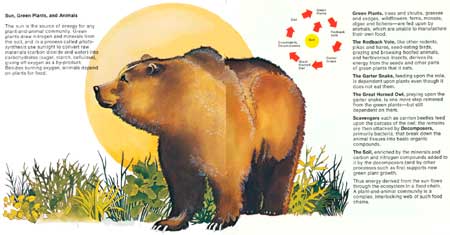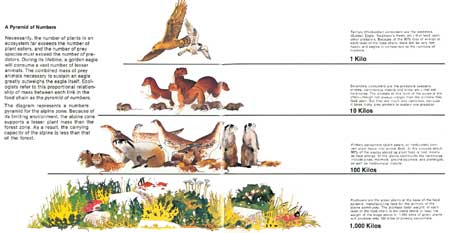
Sun, Green Plants, and Animals
The sun is the source of energy for any plant-and-animal community.
Green plants draw nitrogen and minerals from the soil, and in a process
called photosynthesis use sunlight to convert raw materials
(carbon dioxide and water) into carbohydrates (sugar, starch,
cellulose), giving off oxygen as a by-product. Besides burning oxygen,
animals depend on plants for food.
Green Plants, trees and shrubs, grasses and sedges, wildflowers,
ferns, mosses, algae and lichens—are fed upon by animals, which are
unable to manufacture their own food.
The Redback Vole, like other rodents, pikas and hares,
seed-eating birds, grazing and browsing hoofed animals, and herbivorous
insects, derives its energy from the seeds and other parts of green
plants that it eats.
The Garter Snake, feeding upon the vole, is dependent upon plants
even though it does not eat them.
The Great Horned Owl, preying upon the garter snake, is one more
step removed from the green plants—but still dependent on
them.
Scavengers such as carrion beetles feed upon the carcass of the
owl; the remains are then attacked by Decomposers, primarily
bacteria, that break down the animal tissues into basic organic
compounds.
The Soil, enriched by the minerals and carbon and nitrogen
compounds added to it by the decomposers (and by other processes such as
fire) supports new green plant growth.
Thus energy derived from the sun flows through the ecosystem in a
food chain. A plant-and-animal community is a complex,
interlocking web of such food chains.
(click on above image for an enlargement in a new window)
|

A Pyramid of Numbers
Necessarily, the number of plants in an ecosystem far exceeds the number
of plant eaters, and the number of prey species must exceed the number
of predators. During its lifetime, a golden eagle will consume a vast
number of lesser animals. The combined mass of prey animals necessary to
sustain an eagle greatly outweighs the eagle itself. Ecologists refer to
this proportional relationship of mass between each link in the food
chain as the pyramid of numbers.
The diagram represents a numbers pyramid for the alpine zone. Because of
its limiting environment, the alpine zone supports a lesser plant mass
than the forest zone. As a result, the carrying capacity of the alpine
is less than that of the forest.
Tertiary (third-order) consumers are the predators (Golden Eagle,
Swainson's Hawk, etc.) that feed upon other predators. Because of the
90% loss of energy at each level of the food chain, there will be very
few hawks and eagles in comparison to the numbers of marmots. 1
Kilo
Secondary consumers are the predators (weasels, shrews,
carnivorous insects and birds, etc.) that eat herbivores. The animals at
this level of the pyramid are often—though not always—larger
than the animals they feed upon. But they are much less numerous,
because it takes many prey animals to sustain one predator. 10
Kilos
Primary consumers (plant eaters, or herbivores) convert plant
tissue into animal flesh. In the process about 90% of the energy stored
as plant food is lost, mostly as heat energy. In the alpine community
the herbivores include pikas, marmots, ground squirrels, and ptarmigan,
as well as herbivorous insects. 100 Kilos
Producers are the green plants at the base of the food pyramid,
manufacturing food for the animals of the alpine community. The biomass
(total weight) of each level of the food chain is ten times (more or
less) the weight of the stage above it: 1,000 kilos of green plants will
produce only 100 kilos of primary consumers. 1,000 Kilos
(click on above image for an enlargement in a new window)
|

|

|
|


